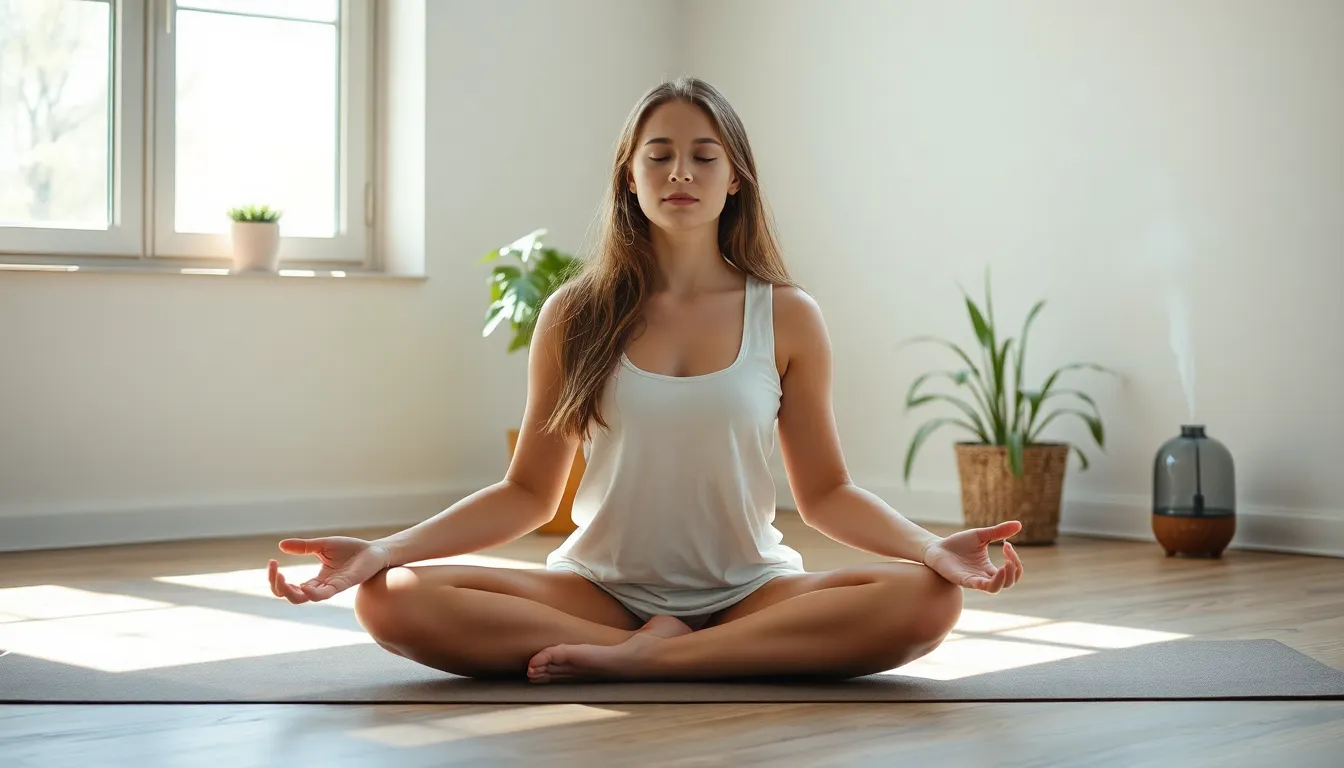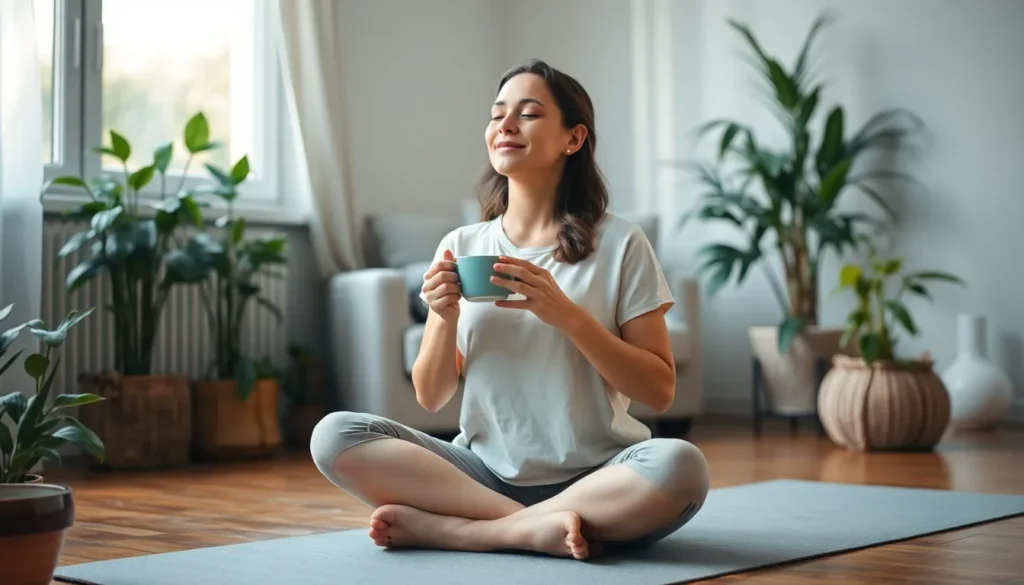In a world that often feels like a chaotic circus, finding ways to calm the mind and body is more important than ever. Soothing techniques are like a secret weapon against stress, anxiety, and the occasional existential crisis. Whether it’s a gentle breath, a warm cup of tea, or a dance party in the living room, these methods can transform a frazzled day into a serene experience.
Table of Contents
ToggleWhat Are Soothing Techniques?
Soothing techniques encompass various methods aimed at promoting relaxation and reducing stress. These strategies effectively alleviate anxiety and restore a sense of calm during hectic moments. Examples include deep breathing exercises and mindfulness practices, which focus on grounding individuals in the present.
Gentle movements, such as yoga or stretching, contribute to both physical and mental relaxation. A warm cup of herbal tea often serves as a comforting ritual that encourages a pause in daily rhythms. Engaging in creative activities, such as drawing or knitting, can also provide a soothing outlet for emotional expression.
Listening to calming music has been shown to lower heart rates and enhance mood. Aromatherapy, utilizing essential oils like lavender, creates a peaceful environment that encourages sensory relaxation. Practicing gratitude through journaling fosters a positive outlook, shifting attention from stressors to joyful experiences.
Incorporating nature into the daily routine offers additional soothing benefits. Walking in a park or spending time in a garden can rejuvenate the mind. These techniques, when practiced consistently, encourage individuals to develop personal rituals that support emotional well-being.
Most importantly, finding the right combination of soothing methods can vary per individual. Experimenting with different techniques leads to discovering what works best for each person. Integrating these practices into daily life cultivates resilience against stress and enhances overall mental health.
Benefits of Soothing Techniques

Soothing techniques offer significant advantages for both physical and mental health. These benefits contribute to overall well-being and resilience against stress.
Physical Benefits
Soothing techniques promote relaxation and reduce physical tension. Deep breathing exercises lower heart rates and improve oxygen circulation. Gentle yoga stretches increase flexibility while calming the muscles. Activities like taking a warm bath or enjoying aromatherapy soothe the body and release built-up tension. Engaging with nature fosters a sense of tranquility and rejuvenates energy levels. Regular practice of these methods may lead to better sleep quality and lower blood pressure, enhancing overall health.
Mental Benefits
Mental clarity improves significantly with soothing techniques. Practicing mindfulness reduces anxiety and enhances focus. Listening to calming music may elevate mood and decrease stress levels. Engaging in creative activities like painting or writing channels emotions positively, providing a mental release. Journaling gratitude promotes a more positive mindset, helping individuals shift their perspective. By incorporating these techniques into daily life, individuals cultivate more resilience, enhancing emotional well-being and coping skills.
Popular Soothing Techniques
Soothing techniques serve as essential tools for managing stress and promoting relaxation. Several effective methods can enhance emotional well-being.
Deep Breathing Exercises
Deep breathing exercises aid in reducing anxiety and improving focus. They typically involve inhaling deeply through the nose, holding the breath for a few seconds, and exhaling slowly through the mouth. Practicing these exercises can activate the body’s relaxation response, promoting a sense of calm. Incorporating this practice into daily routines can lead to improved mental clarity and increased resilience against stress.
Progressive Muscle Relaxation
Progressive muscle relaxation (PMR) helps in releasing tension throughout the body. This technique requires systematically tensing and relaxing different muscle groups, starting from the toes and moving up to the head. Engaging in PMR encourages increased awareness of physical sensations and promotes overall relaxation. Regular practice can contribute to improved sleep quality and reduced feelings of frustration or anxiety.
Guided Imagery
Guided imagery facilitates relaxation through visualization techniques. This approach entails picturing serene environments or peaceful experiences, often facilitated by an audio guide or instructor. Immersing oneself in calming images can transport the mind away from stressors, fostering a tranquil state. Utilizing guided imagery regularly can enhance emotional stability and support better mental health.
Soothing Techniques for Different Situations
Soothing techniques can effectively address various situations requiring calm and relaxation. Here are some methods tailored for specific needs.
Stress Relief
Deep breathing exercises provide immediate stress relief. Practicing techniques like inhaling deeply for four counts and exhaling for six can quickly lower anxiety levels. Engaging in mindful reflection encourages participants to focus on the present moment. Physical activities, such as light yoga or stretching, release built-up tension in the body. Listening to calming music can also create a peaceful atmosphere, promoting relaxation. Activities outdoors, like nature walks, enhance overall well-being and reduce stress significantly.
Sleep Improvement
Creating a bedtime routine prepares the mind and body for sleep. Techniques such as limiting screen time before bed help create a restful environment. Practicing progressive muscle relaxation can soothe the body, allowing easier transitions into sleep. Herbal teas, like chamomile or lavender, offer calming effects that promote relaxation. Additionally, maintaining a cool and dark room encourages better sleep quality. Incorporating mindfulness meditation before bedtime further enhances feelings of tranquility, leading to improved sleep duration and restful nights.
Anxiety Management
Grounding techniques help individuals navigate anxiety effectively. Engaging in sensory activities, such as holding an object and focusing on its texture, redirects attention from anxious thoughts. Journaling offers a platform to articulate feelings, fostering clarity and control. Various breathing methods, including box breathing, allow practitioners to regain focus and calm their racing thoughts. Practicing gratitude through daily affirmations can shift perspectives towards positivity, which minimizes anxiety levels. Regular exercise is also beneficial, as it releases endorphins, improving mood and resilience against anxiety.
Embracing soothing techniques can transform daily life by fostering relaxation and enhancing emotional resilience. By exploring various methods like deep breathing, mindfulness, and creative expression, individuals can discover what resonates best with them.
These techniques not only address immediate stress but also contribute to long-term mental and physical wellness. Incorporating soothing practices into routines can lead to improved clarity, better sleep, and a more positive outlook on life.
Ultimately, the journey towards emotional well-being is unique for everyone. With a willingness to experiment and adapt, anyone can cultivate a more peaceful and fulfilling existence amidst life’s challenges.






